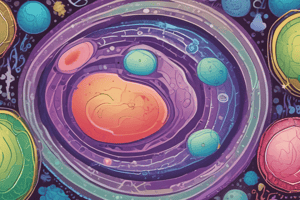Podcast
Questions and Answers
What is the primary structure of a protein?
What is the primary structure of a protein?
- The sequence of amino acids in a polypeptide chain (correct)
- The three-dimensional conformation of a polypeptide in its native state
- The local spatial arrangement of the main-chain atoms in a segment of polypeptide chain
- The way subunits of a multisubunit protein fit together
What is the tertiary structure of a protein?
What is the tertiary structure of a protein?
- The sequence of amino acids in a polypeptide chain
- The helical conformation of a polypeptide chain
- The three-dimensional conformation of a polypeptide in its native, folded state (correct)
- The local spatial arrangement of the main-chain atoms in a segment of polypeptide chain
What is the quaternary structure of a protein?
What is the quaternary structure of a protein?
- The helical conformation of a polypeptide chain
- The three-dimensional structure of a multisubunit protein, particularly the way the subunits fit together (correct)
- The sequence of amino acids in a polypeptide chain
- The local spatial arrangement of the main-chain atoms in a segment of polypeptide chain
What is the secondary structure of a protein?
What is the secondary structure of a protein?
What stabilizes the structure of an α-helix?
What stabilizes the structure of an α-helix?
What is the main characteristic of a β-pleated sheet?
What is the main characteristic of a β-pleated sheet?
What amino acid residues are involved in a 180° β-turn?
What amino acid residues are involved in a 180° β-turn?
What stabilizes the tertiary structure of proteins?
What stabilizes the tertiary structure of proteins?
What defines the quaternary structure of proteins?
What defines the quaternary structure of proteins?
What type of interaction stabilizes the α-helix structure?
What type of interaction stabilizes the α-helix structure?
What characterizes the β-turns in a polypeptide chain?
What characterizes the β-turns in a polypeptide chain?
What is the primary stabilizing force in a β-pleated sheet structure?
What is the primary stabilizing force in a β-pleated sheet structure?
Flashcards
What is the primary structure of a protein?
What is the primary structure of a protein?
The sequence of amino acids in a polypeptide chain.
What is the tertiary structure of a protein?
What is the tertiary structure of a protein?
The three-dimensional conformation of a single polypeptide chain.
What is the quaternary structure of a protein?
What is the quaternary structure of a protein?
The three-dimensional arrangement of multiple polypeptide chains (subunits) in a protein.
What is the secondary structure of a protein?
What is the secondary structure of a protein?
Signup and view all the flashcards
What stabilizes the structure of an α-helix?
What stabilizes the structure of an α-helix?
Signup and view all the flashcards
What is the main characteristic of a β-pleated sheet?
What is the main characteristic of a β-pleated sheet?
Signup and view all the flashcards
What amino acid residues are involved in a 180° β-turn?
What amino acid residues are involved in a 180° β-turn?
Signup and view all the flashcards
What stabilizes the tertiary structure of proteins?
What stabilizes the tertiary structure of proteins?
Signup and view all the flashcards
What defines the quaternary structure of proteins?
What defines the quaternary structure of proteins?
Signup and view all the flashcards
What type of interaction stabilizes the α-helix structure?
What type of interaction stabilizes the α-helix structure?
Signup and view all the flashcards
What characterizes the β-turns in a polypeptide chain?
What characterizes the β-turns in a polypeptide chain?
Signup and view all the flashcards
What is the primary stabilizing force in a β-pleated sheet structure?
What is the primary stabilizing force in a β-pleated sheet structure?
Signup and view all the flashcards
Study Notes
Primary Structure of a Protein
- The sequence of amino acids in a protein is its primary structure.
Secondary Structure of a Protein
- The secondary structure of a protein refers to the specific arrangements of amino acids, such as α-helices and β-pleated sheets.
- α-Helices are stabilized by hydrogen bonds between the carbonyl oxygen and amino hydrogens.
- The main characteristic of a β-pleated sheet is that it has a zig-zag pattern, with alternating amino acids on either side of the sheet.
- β-Turns occur when there is a 180° turn in the polypeptide chain, often involving residues like glycine or proline.
Tertiary Structure of a Protein
- The tertiary structure of a protein refers to its overall 3D shape.
- The tertiary structure of proteins is stabilized by weak bonds, such as hydrophobic interactions, ionic bonds, and disulfide bonds.
Quaternary Structure of a Protein
- The quaternary structure of a protein refers to the arrangement of multiple polypeptide chains in a protein.
- The quaternary structure of proteins is defined by the interactions between polypeptide chains, such as hydrogen bonds, ionic bonds, and disulfide bonds.
Studying That Suits You
Use AI to generate personalized quizzes and flashcards to suit your learning preferences.




